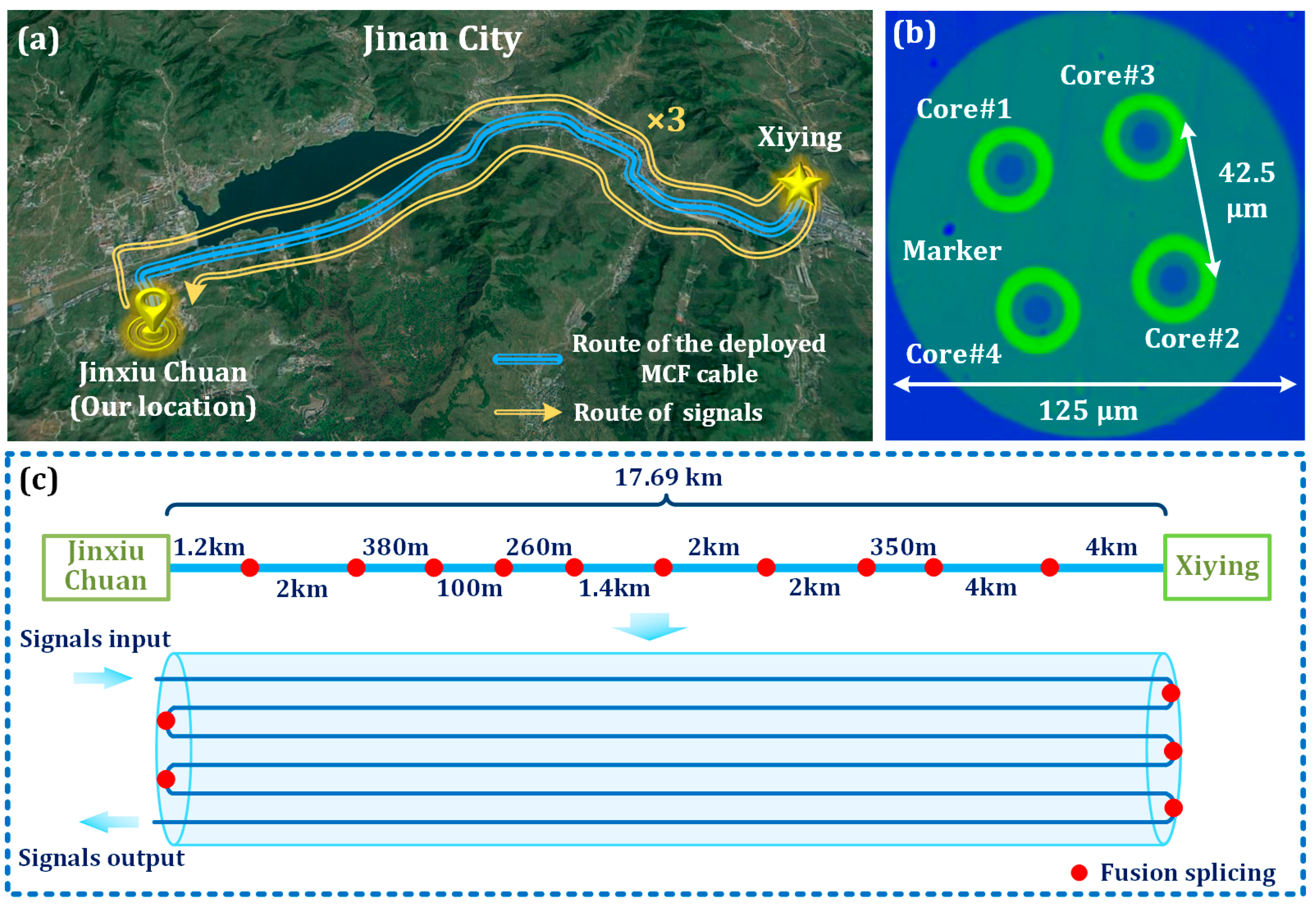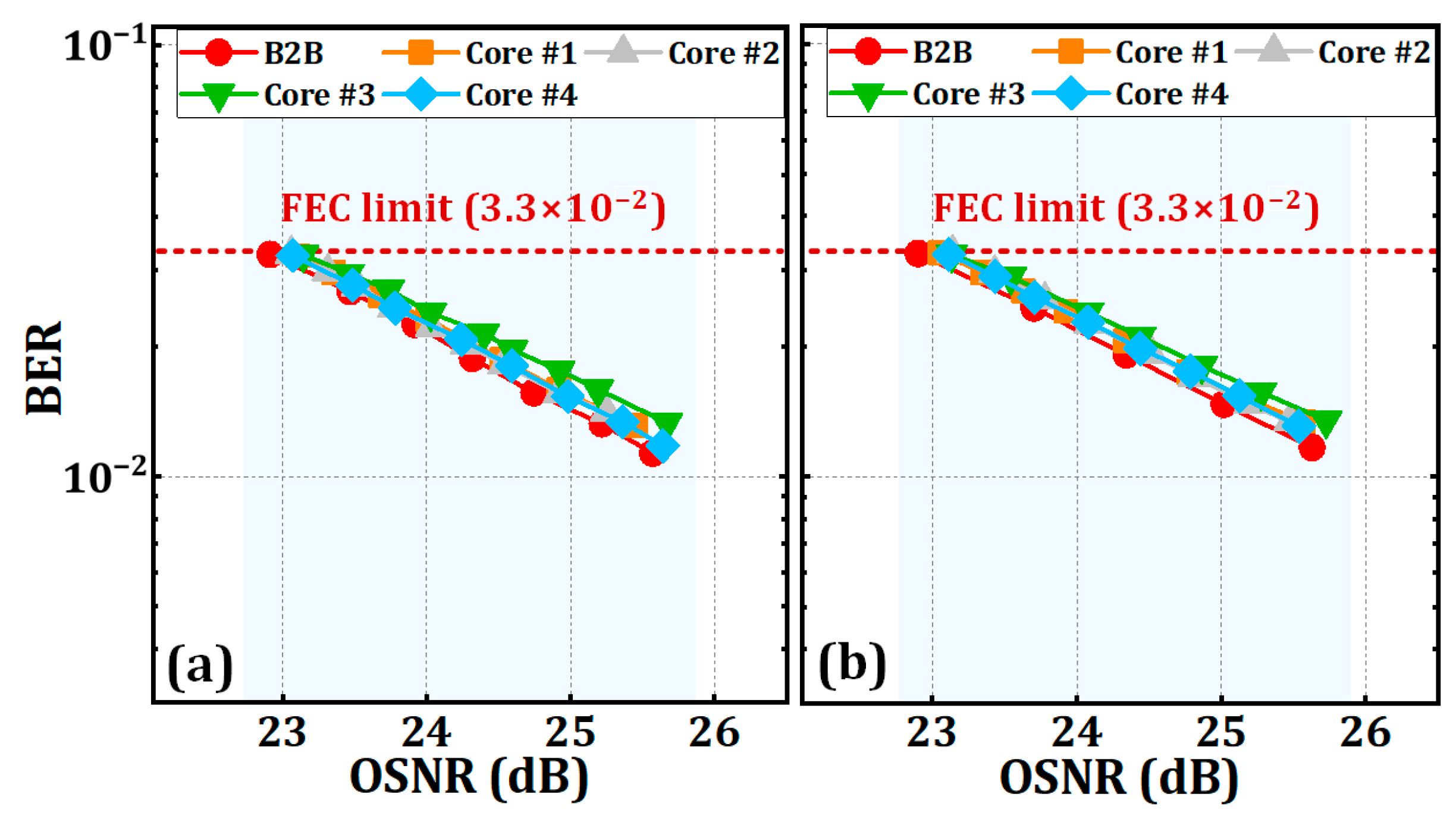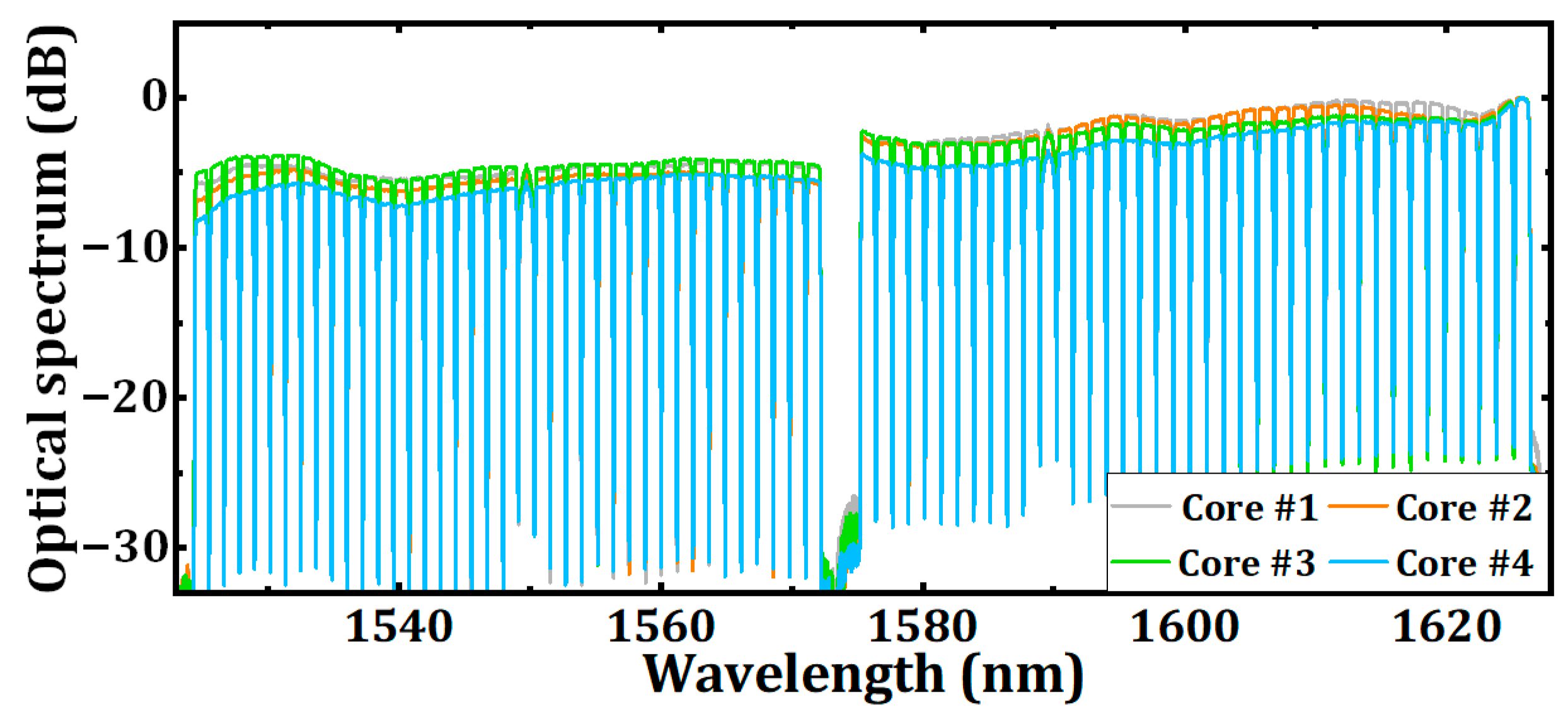Real-Time Unrepeated Long-Span Field Trial over Deployed 4-Core Fiber Cable Using Commercial 130-Gbaud PCS-16QAM 800 Gb/s OTN Transceivers
Abstract
1. Introduction
2. The Field-Deployed 4-Core MCF Cable
3. Experimental Setup of the CDM Transmission System
4. Experimental Results of the Field Trial
5. Discussion and Technological Prospects
5.1. Discussion and Technological Prospects of the 800 Gb/s OTN Transceivers
5.2. Discussion on Further Improving the Performance of MCF Cables and Their Future Applications
6. Conclusions
Author Contributions
Funding
Institutional Review Board Statement
Informed Consent Statement
Data Availability Statement
Conflicts of Interest
References
- Kobayashi, T.; Shimizu, S.; Kawai, A.; Nakamura, M.; Abe, M.; Kazama, T.; Umeki, T.; Nagatani, M.; Kimura, K.; Wakita, H. C+L+U-Band 14.85-THz WDM Transmission Over 80-km-Span G.654.E Fiber with Hybrid PPLN-OPA/EDFA U-Band Lumped Repeater Using 144-Gbaud PCS-QAM Signals. In Proceedings of the 2024 Optical Fiber Communications Conference and Exhibition (OFC), San Diego, CA, USA, 24–28 March 2024. [Google Scholar]
- Puttnam, B.J.; Luis, R.S.; Phillips, I.; Tan, M.; Donodin, A.; Pratiwi, D.; Dallachiesa, L.; Huang, Y.; Mazur, M.; Fontaine, N.K.; et al. 402 Tb/s GMI data-rate OESCLU-band Transmission. In Proceedings of the 2024 Optical Fiber Communications Conference and Exhibition (OFC), San Diego, CA, USA, 24–28 March 2024. [Google Scholar]
- Ryf, R.; Randel, S.; Gnauck, A.H.; Bolle, C.A.; Sierra, A.; Mumtaz, S.; Esmaeelpour, M.; Burrows, E.C.; Essiambre, R.-J.; Winzer, P.J.; et al. Mode-division multiplexing over 96 km of few-mode fiber using coherent 6 × 6 MIMO processing. J. Light. Technol. 2012, 30, 521–531. [Google Scholar]
- Richardson, D.J.; Fini, J.M.; Nelson, L.E. Space-division multiplexing in optical fibres. Nat. Photonics 2013, 7, 354–362. [Google Scholar] [CrossRef]
- Zhang, D.; Zuo, M.; Chen, H.; Ge, D.; Feng, Z.; Yan, B.; Wang, D.; Shi, H.; Cao, S.; Li, Y.; et al. Technological Prospection and Requirements of 800G Transmission Systems for Ultra-Long-Haul All-Optical Terrestrial Backbone Networks. J. Light. Technol. 2023, 41, 3774–3782. [Google Scholar] [CrossRef]
- Horvath, T.; Radil, J.; Sima, J. Interaction Analysis: Coherent vs. Legacy Transmission Data Systems for ITU Grid Spacing. In Proceedings of the 2024 Optical Engineering + Applications, San Diego, CA, USA, 18–22 August 2024. [Google Scholar]
- Igarashi, K.; Park, K.J.; Tsuritani, T.; Morita, I.; Kim, B.Y. All-fiber-based selective mode multiplexer and demultiplexer for weakly-coupled mode-division multiplexed systems. Opt. Commun. 2018, 408, 58–62. [Google Scholar] [CrossRef]
- Puttnam, B.J.; Hout, M.; Sciullo, G.D.; Luis, R.S.; Rademacher, G.; Sakaguchi, J.; Antonelli, C.; Okonkwo, C.; Furukawa, H. 22.9 Pb/s Data-Rate by Extreme Space-Wavelength Multiplexing. In Proceedings of the 2023 European Conference on Optical Communication (ECOC), Glasgow, Scotland, 1–5 October 2023. [Google Scholar]
- Ryf, R.; Fontaine, N.K.; Wittek, S.; Choutagunta, K.; Mazur, M.; Chen, H.; Alvarado-Zacarias, J.C.; Amezcua-Correa, R.; Capuzzo, M.; Kopf, R.; et al. High-Spectral-Efficiency Mode-Multiplexed Transmission over Graded-Index Multimode Fiber. In Proceedings of the 2018 European Conference on Optical Communication (ECOC), Rome, Italy, 23–27 September 2018. [Google Scholar]
- Zuo, M.; Ge, D.; Gao, Y.; Cui, J.; Huang, S.; Zhou, R.; Guo, Q.; Zhang, Y.; Zhang, D.; Xiao, X.; et al. 3-mode Real-time MDM Transmission Using Single-mode OTN Transceivers over 300 km Weakly-coupled FMF. In Proceedings of the 2022 Optical Fiber Communications Conference and Exhibition (OFC), San Diego, CA, USA, 6–10 March 2022. [Google Scholar]
- Li, G.; Bai, N.; Zhao, N.; Xia, C. Space-division multiplexing: The next frontier in optical communication. Adv. Opt. Photonics 2014, 6, 413–487. [Google Scholar]
- Lin, R.; Pang, X.; Kerrebrouck, J.V.; Verplaetse, M.; Ozolins, O.; Udalcovs, A.; Zhang, L.; Gan, L.; Tang, M.; Fu, S.; et al. Real-time 100 Gbps/λ/core NRZ and EDB IM/DD Transmission over 10 km Multicore Fiber. In Proceedings of the 2018 Optical Fiber Communication Conference (OFC), San Diego, CA, USA, 11–15 March 2018. [Google Scholar]
- Cwalina, S.; Mohammadi, S.K.; Habel, K.; Jungnickel, V.; Freund, R. Demonstration of a Real-Time 100G Ethernet Space Division Multiplexing PON Using a Weakly Coupled Multicore Fiber. In Proceedings of the 2023 International Workshop on Fiber Optics on Access Networks (FOAN), Gent, Belgium, 30–31 October 2023. [Google Scholar]
- Feng, L.; Zhang, A.; Guo, H.; Lou, X.; Wang, D.; Peng, C.; Liu, Y.; Lv, K.; Liu, H.; Huo, X.; et al. Real-Time 179.2Tb/s Transmission using Commercial 400Gb/s Transceivers over 350 km Multicore Fiber. In Proceedings of the 2023 Optical Fiber Communications Conference and Exhibition (OFC), San Diego, CA, USA, 5–9 March 2023. [Google Scholar]
- Kremp, T.; Liang, Y.; McCurdy, A.H. Less Than 0.03 dB Multicore Fiber Passive Fusion Splicing Using New Azimuthal Alignment Algorithm and 3-Electrode Arc-Discharging System. In Proceedings of the 2022 European Conference on Optical Communication (ECOC), Basel, Switzerland, 18–22 September 2022. [Google Scholar]
- Shikama, K.; Abe, Y.; Kishi, T.; Takeda, K.; Fujii, T.; Nishi, H.; Matsui, T.; Aratake, A.; Nakajima, K.; Matsuo, S. Multicore-Fiber Receptacle with Compact Fan-In/Fan-Out Device for SDM Transceiver Applications. J. Light. Technol. 2018, 36, 5815–5822. [Google Scholar]
- Alvarado-Zacarias, J.C.; Antonio-Lopez, J.E.; Habib, M.S.; Gausmann, S.; Wang, N.; Cruz-Delgado, D.; Li, G.; Schulzgen, A.; Amezcua-Correa, A.; Demontmorillon, L.A.; et al. Low-Loss 19 core Fan-in/Fan-out Device Using Reduced-Cladding Graded Index Fibers. In Proceedings of the 2019 Optical Fiber Communications Conference and Exhibition (OFC), San Diego, CA, USA, 5–7 March 2019. [Google Scholar]
- Beppu, S.; Kikuta, M.; Soma, D.; Yaegashi, Y.; Igarashi, K.; Shigihara, M.; Aizawa, K.; Yoshikane, N.; Tsuritani, T. Real-time 6-Mode 19-Core Fiber Transmission. In Proceedings of the 2023 Optical Fiber Communications Conference and Exhibition (OFC), San Diego, CA, USA, 5–9 March 2023. [Google Scholar]
- Sciullo, G.D.; Puttnam, B.J.; Hout, M.; Luis, R.S.; Shaji, D.A.; Rademacher, G.; Okonkwo, C.; Mecozzi, A.; Antonelli, C.; Furukawa, H. 45.7 Tb/s over 12 053 km Transmission with an All-Multi-Core Recirculating-Loop 4-Core-Fiber System. In Proceedings of the 2024 Optical Fiber Communications Conference and Exhibition (OFC), San Diego, CA, USA, 24–28 March 2024. [Google Scholar]
- Soma, D.; Beppu, S.; Miyagawa, Y.; Yoshikane, N.; Tsuritani, T. 114 Pbit/s∙km Transmission using Three Vendor-Installed 60-km Standard Cladding Multi-Core Fiber Spans with Multiple Fusion Splicing. In Proceedings of the 2023 Optical Fiber Communications Conference and Exhibition (OFC), San Diego, CA, USA, 5–9 March 2023. [Google Scholar]
- Chen, Y.; Xiao, Y.; Chen, S.; Xie, F.; Liu, Z.; Wang, D.; Yi, X.; Lu, C.; Li, Z. Field Trials of Communication and Sensing System in Space Division Multiplexing Optical Fiber Cable. IEEE Commun. Mag. 2023, 61, 182–188. [Google Scholar] [CrossRef]
- Guerrier, S.; Mecozzi, A.; Dorize, C.; Antonelli, C.; Dallachiesa, L.; Mardoyan, H.; Awwad, E.; Orsuti, D.; Palmieri, L.; Mazur, M.; et al. Field Trial of High-Resolution Distributed Fiber Sensing over Multicore Fiber in Metropolitan Area with Construction Work Detection using Advanced MIMO-DAS. In Proceedings of the 2023 Optical Fiber Communications Conference and Exhibition (OFC), San Diego, CA, USA, 5–9 March 2023. [Google Scholar]
- Wang, X.; Wang, J.; Chen, Y.; Xiao, Y.; Li, Z.; Chen, Z.; Li, Z.; Wang, D. Field Trial of 7 × 89λ × 256 Gb/s C-Band Classical/CVQKD Co-Existence Transmission over 7-Core Fiber. In Proceedings of the 2023 Asia Communications and Photonics Conference/2023 International Photonics and Optoelectronics Meetings (ACP/POEM), Wuhan, China, 4–7 November 2023. [Google Scholar]
- Zhao, Z.; Wang, Z.; Gao, H.; Dong, J.; Cheng, J.; Zhang, J.; Chen, Z.; Yu, S.; Luo, B.; Guo, H. Modulator Bias Control Based on Bi-PID Algorithm for Optical Time and Frequency Transmission. IEEE Photonics Technol. Lett. 2024, 36, 75–78. [Google Scholar] [CrossRef]
- Cui, J.; Deng, Y.; Liu, Z.; Wang, Y.; Wu, B.; Zhang, C.; Wang, J.; Yan, B.; Zhang, L.; Hao, B.; et al. First real-time single-span 106-km field trial using commercial 130-Gbaud DP-QPSK 400 Gb/s backbone OTN transceivers over deployed multi-core fiber cable. Opt. Commun. 2025, 575, 131308. [Google Scholar] [CrossRef]





| Mode Field Diameter (μm) | Dispersion Coefficient (ps/nm/km) | Attenuation Coefficient (dB/km) | Polarization Mode Dispersion (ps/km1/2) | Cut-Off Wavelength (nm) | Inter-Core Crosstalk (dB/10 km) | Bending Loss with R = 30 mm (dB/100 Turns) |
|---|---|---|---|---|---|---|
| 9.8 | ≤22 | ≤0.21 | ≤0.08 | ≤1300 | ≤−50 | <0.1 |
| Core #1 | Core #2 | Core #3 | Core #4 | |
|---|---|---|---|---|
| Span loss | 33.6 | 33.3 | 32.9 | 33.0 |
| Total crosstalk | −41.4 | −44.6 | −42.1 | −45.3 |
| Bit Rate (Gb/s) | Baud Rate (Gbaud) | Modulation Format | OSNR Threshold (dB) | Input Power of C-Band Signals (dBm) | OSNR After Transmission (dB) | OSNR Margin (dB) |
|---|---|---|---|---|---|---|
| 400 | 130 | QPSK | 16 | +11 | 25.6 | 9.6 |
| 800 | 260 | QPSK | 19.1 | +14 | 28.6 | 9.5 |
| 800 | 130 | PCS-16QAM | 23.2 | +11 | 25.6 | 2.4 |
| 800 | 118 | 16QAM | 24.6 | +10.6 | 25.2 | 0.6 |
| 800 | 98 | PCS-64QAM | 27.4 | +9.8 | 24.4 | −3 |
Disclaimer/Publisher’s Note: The statements, opinions and data contained in all publications are solely those of the individual author(s) and contributor(s) and not of MDPI and/or the editor(s). MDPI and/or the editor(s) disclaim responsibility for any injury to people or property resulting from any ideas, methods, instructions or products referred to in the content. |
© 2025 by the authors. Licensee MDPI, Basel, Switzerland. This article is an open access article distributed under the terms and conditions of the Creative Commons Attribution (CC BY) license (https://creativecommons.org/licenses/by/4.0/).
Share and Cite
Cui, J.; Wu, C.; Liu, Z.; Deng, Y.; Hao, B.; Zhang, L.; Zhang, T.; Wang, Y.; Wu, B.; Zhang, C.; et al. Real-Time Unrepeated Long-Span Field Trial over Deployed 4-Core Fiber Cable Using Commercial 130-Gbaud PCS-16QAM 800 Gb/s OTN Transceivers. Photonics 2025, 12, 319. https://doi.org/10.3390/photonics12040319
Cui J, Wu C, Liu Z, Deng Y, Hao B, Zhang L, Zhang T, Wang Y, Wu B, Zhang C, et al. Real-Time Unrepeated Long-Span Field Trial over Deployed 4-Core Fiber Cable Using Commercial 130-Gbaud PCS-16QAM 800 Gb/s OTN Transceivers. Photonics. 2025; 12(4):319. https://doi.org/10.3390/photonics12040319
Chicago/Turabian StyleCui, Jian, Chao Wu, Zhuo Liu, Yu Deng, Bin Hao, Leimin Zhang, Ting Zhang, Yuxiao Wang, Bin Wu, Chengxing Zhang, and et al. 2025. "Real-Time Unrepeated Long-Span Field Trial over Deployed 4-Core Fiber Cable Using Commercial 130-Gbaud PCS-16QAM 800 Gb/s OTN Transceivers" Photonics 12, no. 4: 319. https://doi.org/10.3390/photonics12040319
APA StyleCui, J., Wu, C., Liu, Z., Deng, Y., Hao, B., Zhang, L., Zhang, T., Wang, Y., Wu, B., Zhang, C., Wang, J., Yan, B., Zhang, L., Chen, Y., Chen, X., Shi, H., Shen, L., Zhang, L., Luo, J., ... Gu, N. (2025). Real-Time Unrepeated Long-Span Field Trial over Deployed 4-Core Fiber Cable Using Commercial 130-Gbaud PCS-16QAM 800 Gb/s OTN Transceivers. Photonics, 12(4), 319. https://doi.org/10.3390/photonics12040319





